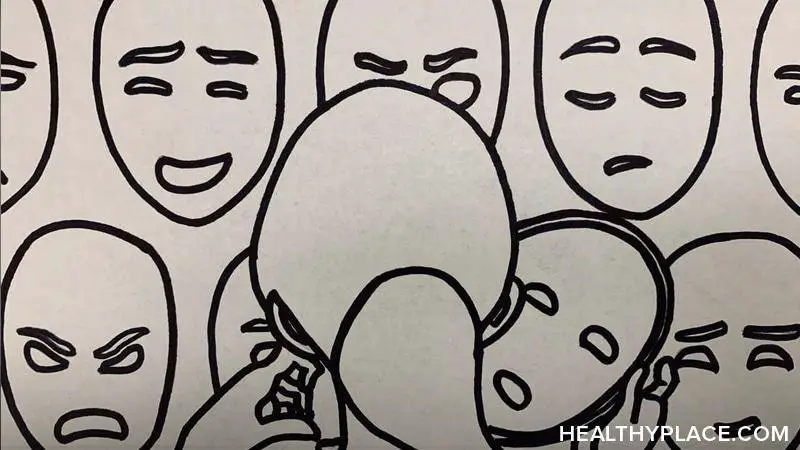Table of Contents
Dissociative Identity Disorder- Everything You Need To Know
What is Dissociative Identity Disorder? Have you ever come across anyone you think to have multiple personalities, if yes, you should know that multiple personality disorder and Dissociative Identity Disorder or DID are the same.
Earlier DID or dissociative identity disorder was named multiple personality disorder. You can call it a complex type of psychological condition in which a person creates another identity in their brain. There are many factors that are responsible as a cause of dissociative identity disorder. These factors include severe trauma in the early childhood or teenage, like extreme and repetitive emotional, sexual, or physical abuse. Due to these traumas, a person goes through series of changes.
What Is Dissociative Identity Disorder?

You can consider Dissociative Identity Disorder to be a very severe form of dissociation. Scientifically Dissociation refers to a mental process that causes and produces a lack of connectivity in a person’s memories, actions, sense of identity, feelings, and thoughts a person has.
This type of personality disorder is thought to arise from many factors combined. Due to all the associated factors, the person goes through mental trauma and acquired dissociative identities. These dissociative identities a person creates after trauma is believed to be a mechanism through which they cope up with the trauma or a coping mechanism. The person involved with any sort of trauma literally shuts all the emotions or dissociates themselves to experience trauma, violent, or painful experiences.
Who Is At More Risk Of Acquiring Dissociative Identity Disorder?
According to much research conducted on Dissociative Identity Disorder, it has become clear that the causes of this disorder are likely a psychological reversion or response to environmental or interpersonal stresses. It is particularly during early childhood when any abuse or emotional neglect might interfere with the child’s personality development.
It is seen that 99% of total people who have developed dissociative identity disorders have admitted histories of overpowering, recurring, and life-threatening trauma or disturbances in their lives at a sensitive stage of development during their childhood. Usually, it is seen before the age of six years.
There has to be no overt sexual or physical abuse for the dissociation to occur in a person, even emotional abuse or persistent emotional neglect can lead to acquiring DID. Studies have shown that in families where the parents are quite unpredictable and very strict or frightening, there also dissociation may occur in the child.
It has been seen that out of the total population, 1% of people experience Dissociative identity disorder.
How To Identify Dissociative Identity Disorder?

You might be wondering that if 1% population undergoes such mental conditions, how do we identify them in the workspace or how do we deal nicely with people. Read this carefully to understand.
Dissociative Identity Disorder is usually characterized by the existence of two or more split or distinct identities or personalities in a person that has power over the person’s behavior. When a person undergoes dissociative identity disorder, it is often seen that they are unable to recall any key information that is personal to them. When a person has DID there are very high and distinct memory gaps or variations. These memory variations keep fluctuating.
It is important to note that every person has certain ways of experiencing DID and it differs from person to person. These identities present in one single person have their own sex, race, or age. Not only age and sex, but each personality or identity also has different gestures, postures, and a way in which they walk which are quite different than the actual person or host. Sometimes these personalities present within can be imaginary animals and sometimes they can be people.
When each of these personalities reveals itself and shows different gestures than the person, it is termed as switching. When switching occurs the other personality has full control over individuals behavior and thoughts. You cannot expect everyone to switch within seconds, this may take seconds to minutes to days.
Some people seek treatments through hypnosis. In this process, the personalities or you may call them “alters” are responsive to what the therapists request them to.
When talking about different symptoms of recognition, some other symptoms that are associated with Dissociative identity disorder are amnesia, headache, trances, time loss, and experiences that are “out of the body”.
It is seen in some people having DID that they acquire tendencies of self-persecution, violence (on self and outward inflicted), and self-sabotage. For example, you can understand and recognize some people having DID do things that they wouldn’t actually do if they were real self like driving recklessly, speeding, stealing something from friends or employers, etc. They are compelled to perform different things by their “alters”.
When researchers talked to people having DID, it came to their knowledge that some people having dissociative identity disorder described DID as a feeling of being a passenger in their own body rather than being a driver. To be more precise, they simply meant they had no choice on “alters” and what they do. They do not even remember due to a memory gap.
There are few ways described in which the psychological processes of a person having DID changes the mode of living and thoughts a person has, these ways include:
- Depersonalization: This includes a sense of being separated or detached from an individual’s body. In simple language, it is called the “out of the body” experience a person has when they acquire DID.
- Derealization: It is a feeling or emotion that the entire world is unreal or far away. It may also mean the world has become foggy.
- Amnesia: As the personality keeps switching, many things are not clear to the brain. This is the failure to remember or recall personal information that is so huge or extensive that the person cannot blame it on normal forgetfulness. In a person having DID, some micro amnesia can also occur. In these amnesias, a person would not remember engaging in simple discussions. Frequent amnesia can occur when the person will not remember meaningful conversations just in few seconds.
- Identity Alteration or Identity Confusion: Both these include a sense of confusion on who the person is. As an example you can understand this as the person having identity confusion will have issues defining and naming out things that give them pleasure of things they are interested in doing. They will also have confusion in determining their social or political viewpoints. Sometimes they cannot even recall their sexual orientation or their ambitions in life. Other than these things, the person also faces alterations or distortions in situation, place, and time.
It is acknowledged that these dissociated personalities are not always fully mature. They usually represent a disjointed sense of identity. Amnesia is often associated with Dissociative Identity Disorder. Various personalities or identities present within the body remember different aspects related to autobiographical information. Usually, a “host” identity is present which actually refers to the actual person’s name but this host is unaware of the existence or presence of various personalities associated with them. This is such an ironic situation.
Diagnosis Of Dissociative Identity Disorder

It takes time to diagnose Dissociative Identity Disorder. It is also estimated that some individuals having dissociative personalities have spent nearly 7 years in their mental state or health system before getting a proper and accurate diagnosis of their issues.
This is very common because all the symptoms and issues associated with Dissociative identity disorder are also very common with other types of mental health issues and psychiatric diagnoses. In fact, it is commonly observed that many people who are suffering from dissociative personality disorders are also linked to coexisting diagnoses of other disorders like a borderline personality disorder, anxiety, and depression.
According to DSM-5, there are 5 criteria through which dissociatve identity disorder can be diagnosed, these are:
- Either two or more two distinct identities or personalities are present. Each personality has its own enduring pattern or way to perceive things and relate to different people and objects. Their thinking of self and environment also differs from one another.
- The occurrence of Amnesia. There may be gaps in the memory to recall events occurring every day which includes personal information, events of trauma, discussions one has engaged in, etc.
- The person having DID is usually distressed by this disorder and has various troubles in functioning in their major areas of life due to this disorder.
- The disturbances that occur during this are not a part of religious practices or normal culture.
- These symptoms cannot usually occur due to any direct physiological effects related to substances like chaotic behavior or backouts after alcohol consumption or drug consumption. Also, it cannot occur due to medical conditions like partial seizures.
These distinct personalities might serve very diverse and different roles in helping the person with DID to cope up with dilemmas in life and help reduce the stress of trauma they had. For example, when the individual is initially diagnosed, there are 2 to 4 identities or “alters” present inside their brain. Over the course of treatment that goes on, these personalities can become 13 to 15 from 2 to 3.
Switching between these personalities may occur within few seconds or even takes days. This is caused by changing environmental conditions or events in life.
Other Psychiatric Illness Associated With Dissociatve Identity Disorder
Along with multiple personalities or dissociation into split personalities or identities, people having DID might also experience and go through certain other disorders related to it. These disorders, illness, and their symptoms are:
- Mood swings
- Depression
- Suicidal tendencies.
- Anxiety or panic attacks.
- Sleeping disorders like night terrors, insomnia, or sleepwalking.
- Phobias due to flashbacks or any triggers.
- Alcohol and drug abuse
- Rituals and compulsions
- Eating disorders
- Symptoms that are psychotic like including visual and auditory hallucinations.
Symptoms In Adults Include:
- A sense of having no control over time or losing time
- Feeling of detachment
- Behavior that is out of character
- Gaps in memory
Symptoms In Children having DID Includes:
- Having distressing memories and dreams
- Being zoning out and being unresponsive towards many things.
- The mental stress of trauma
- The physical reaction to any triggers
- Unexpected changes in food habits and interest due to a switch in personality.
Are There Popular Personalities That Have Undergone Dissociative Identity Disorder?
It is not only seen in common people, many famous people also undergo a lot of stress and trauma. These disorders can occur in anyone irrespective of their money and fame. Some famous people that have experienced Dissociative Identity Disorders include Adam Duritz, Roseanne Bar, and Herschel Walker.
Herschel Walker is a retired NFL star. He wrote a book about his struggles with a dissociative identity disorder. He mentioned some drastic steps taken by him which included suicidal attempts.
He had mentioned that he had many disconnects from his childhood to his professional leagues. To cope up with all the things that happened to him, he developed a very tough personality that did not feel left out or did not feel lonely. He also suppressed his side of personality that had to act out due to anger.
The alters he created were able to withstand every abuse he had felt. Other alters present in his personality came to him to help him out when he rose to national fame.
All the treatments we went through after diagnosis helped him come out of this disorder.
Treatments For Dissociative Identity Disorder

Currently, there is no availability of any evidence-based formal type of treatments that can fully cure Dissociatve identity disorder. Many treatments given are based on certain controversial case reports.
Although there is no cure as of now for treating dissociatve personality disorder, taking a long-term treatment could be really helpful and precise way to deal with it.
You have to stay highly committed to the treatment in order to ger recovery. Some effective treatments of DID are:
1. Psychotherapy
This is also known as talk therapy. This therapy is specially designed to work thoroughly through everything and anything that has caused this disease to take root in a person. All the triggers that trigger DID are found out by taking a session of talk therapy. The goal of talk therapies in DID is to “fuse” all the different personality traits into a single consolidated personality which is thought to be the main personality that controls all the triggers.
Usually, family members are also included in this therapy to provide support and witness the witching of different personalities.
2. Hypnotherapy
This therapy is often used in conjunction with talk therapy or psychotherapy. Clinical hypnosis is carried out that can be immensely useful in accessing all the repressed memories. It is also useful in controlling some behaviors that are problematic in nature and accompanies DID. The main purpose is to integrate different personalities into a single identity.
3. Cognitive Behavioral Therapy
It is a form of psychotherapy only. The focus of cognitive behavioral therapy is to focus on changing and improving thinking patterns that are dysfunctional at present. The behavior and feelings of a person are also taken into consideration in this.
4. EMDR
This technique of Eye Movement Desensitization and Reprocessing was initially designed to help people provide treatment with flashbacks, persistent nightmares, and some other symptoms associated with post-traumatic stress disorders or PTSD. This is now also used for people having dissociative identity disorder to get knowledge and deal with their traumas.
5. DBT
DBT or Dialectic Behavior Therapy is also a form of psychotherapy. It is often associated with dealing with people having severe personality disturbances. These disturbances include dissociatve symptoms that usually occur after experiencing trauma and abuse.
6. Adjunctive therapy
Therapies such as movement and art therapy are shown to help people who have gone through any trauma in their life due to which they have shut off their part of the brain to deal with trauma. In this therapy, the people will be able to connect with parts of their brain that they no longer use or shut off.
Some common medications that treat related disorders with DID can be prescribed by doctors after checking your case completely. These include:
- Anti-anxiety medications
- Antidepressants
- Antipsychotic drugs
Till now there have been no established treatments od dissociate identity disorder that includes any sort of medication. Using therapies is a mainstream treatment used by many people and the most preferred way to deal with dissociatve identity disorder. Treating diseases that usually co-occur with Dissociative identity disorder like depression, or disorders involving substance abuse is important for overall treatment and cure.
The symptoms of dissociative identity disorder often come with anxiety, depression, etc. There are medicines that can help cure and treat these problems that co-exist with DID. Nowadays a new approach for treating depression is very prominent and researches are going on. This is the use of ketamine to treat depression.
These were some points of information you need to know about dissociatve personality disorder including its causes, symptoms, and treatments that includes therapies.
You can seek help from healthcare experts if you feel you have time gaps in your memory without substance abuse. There are people who have successfully recovered from past traumas, even you can easily recover by seeking help.


